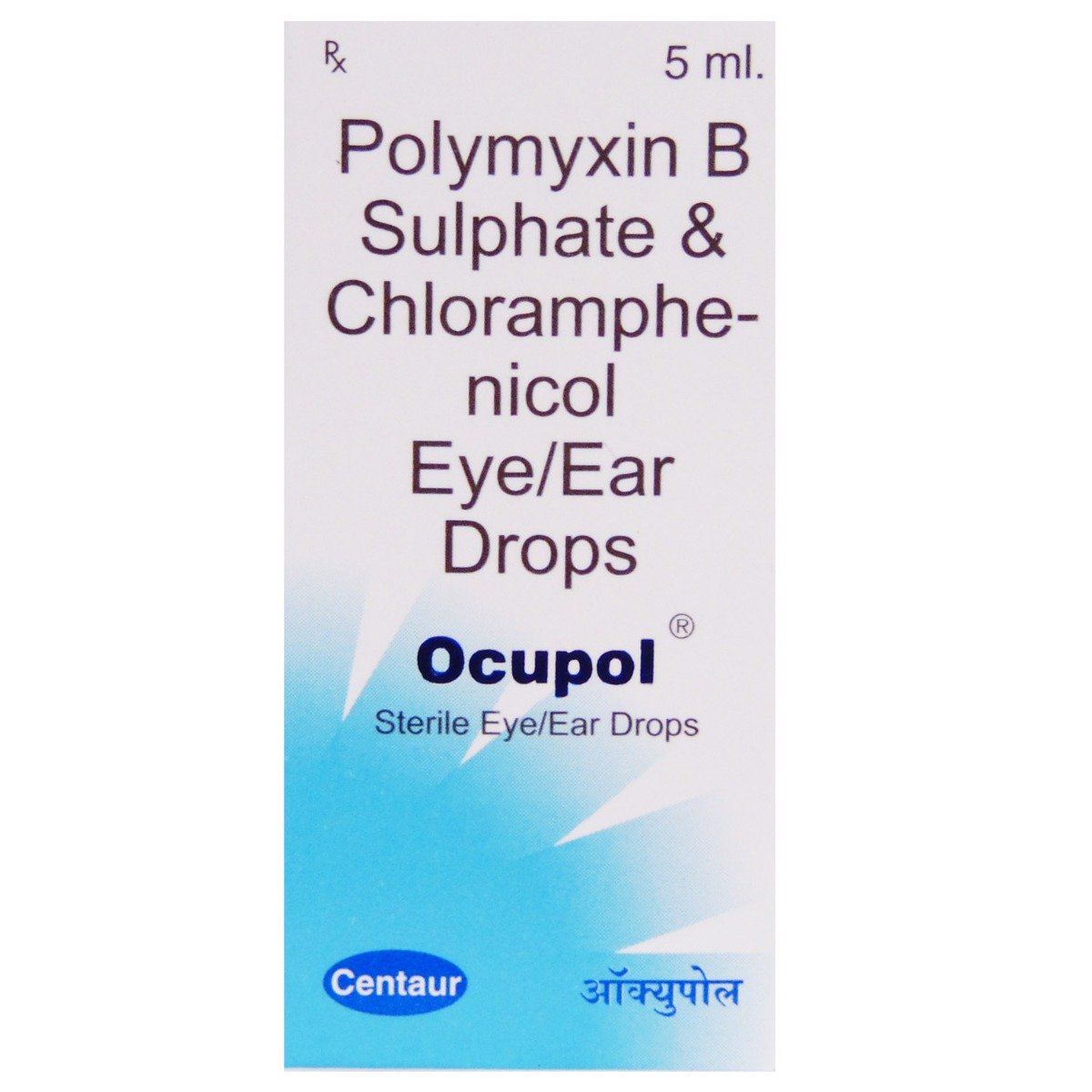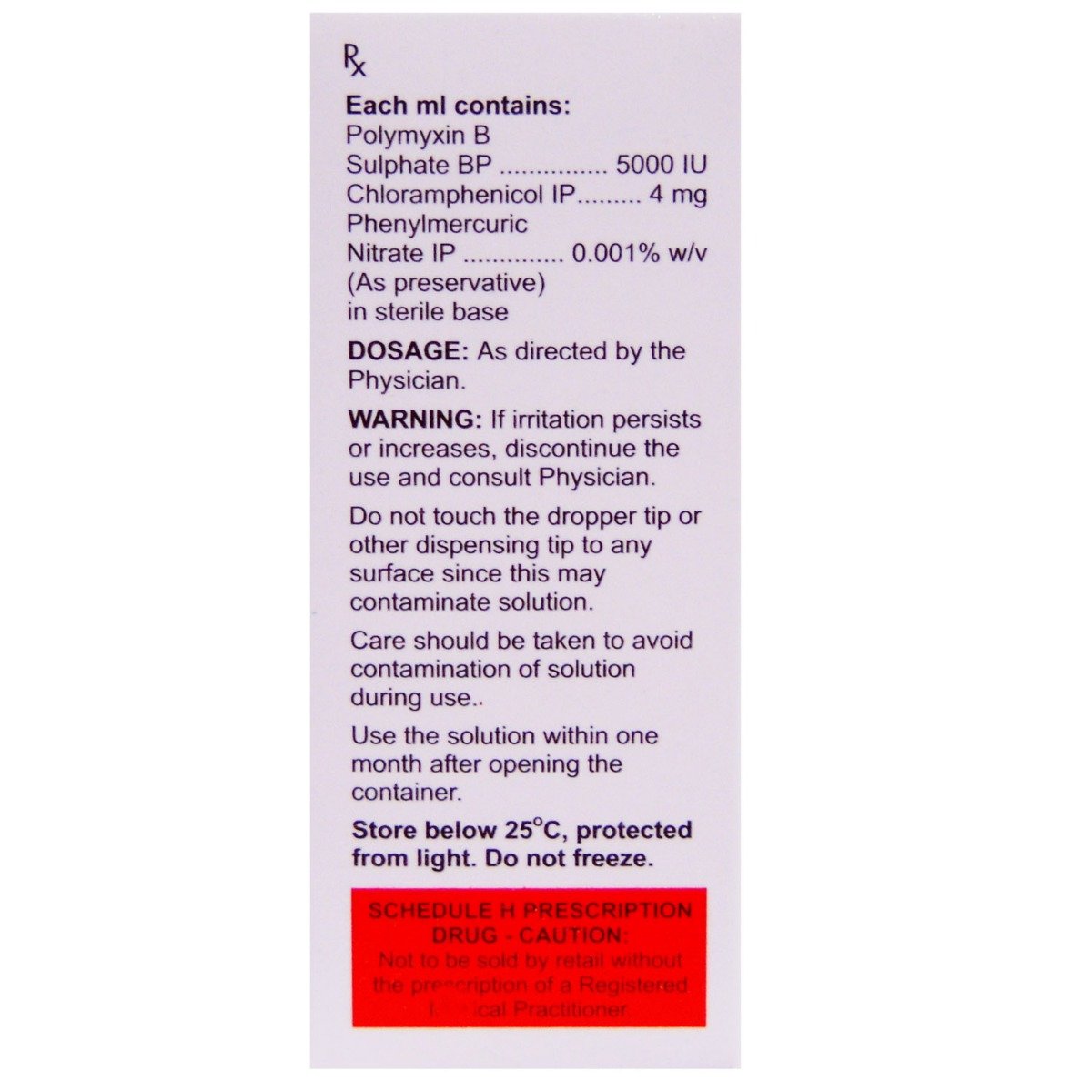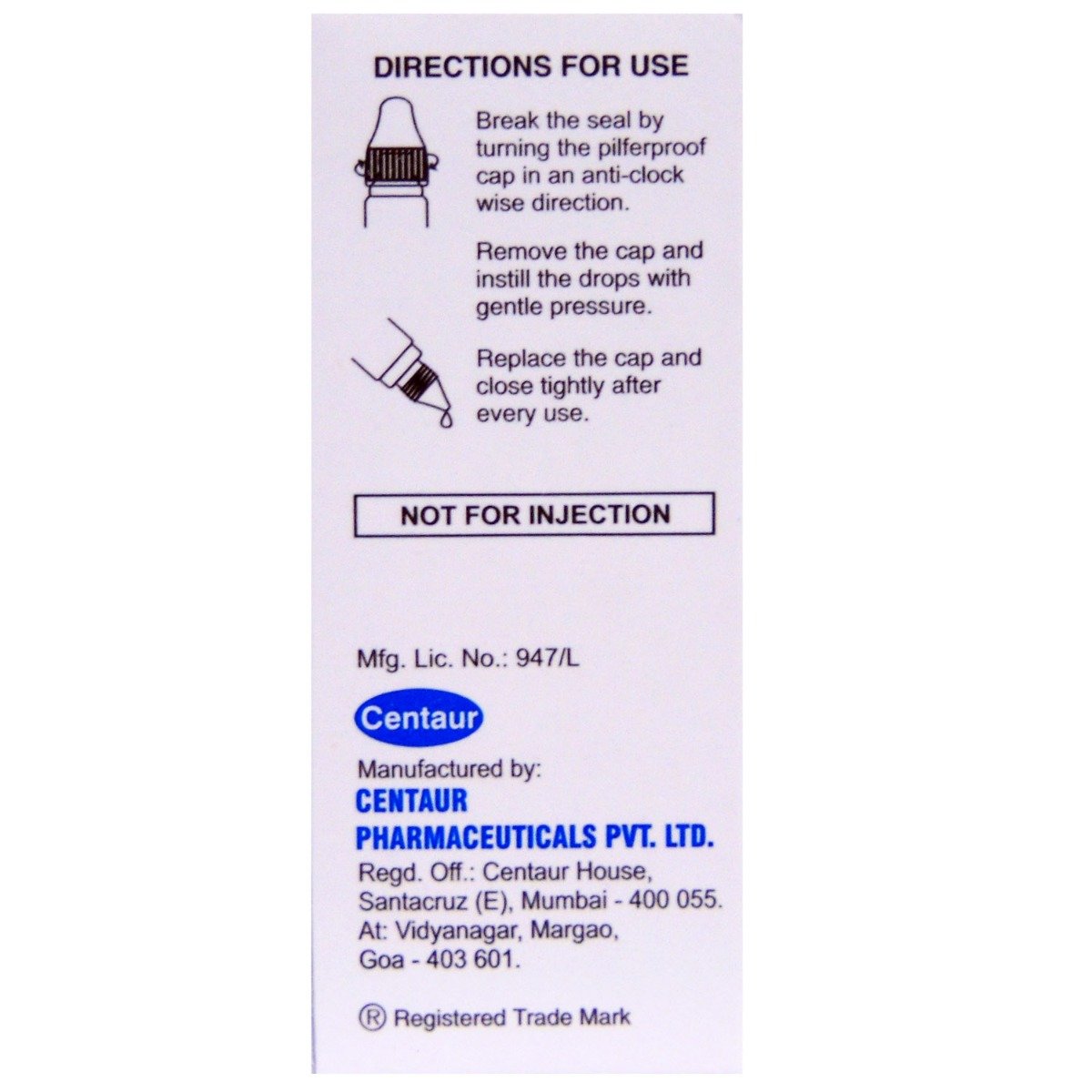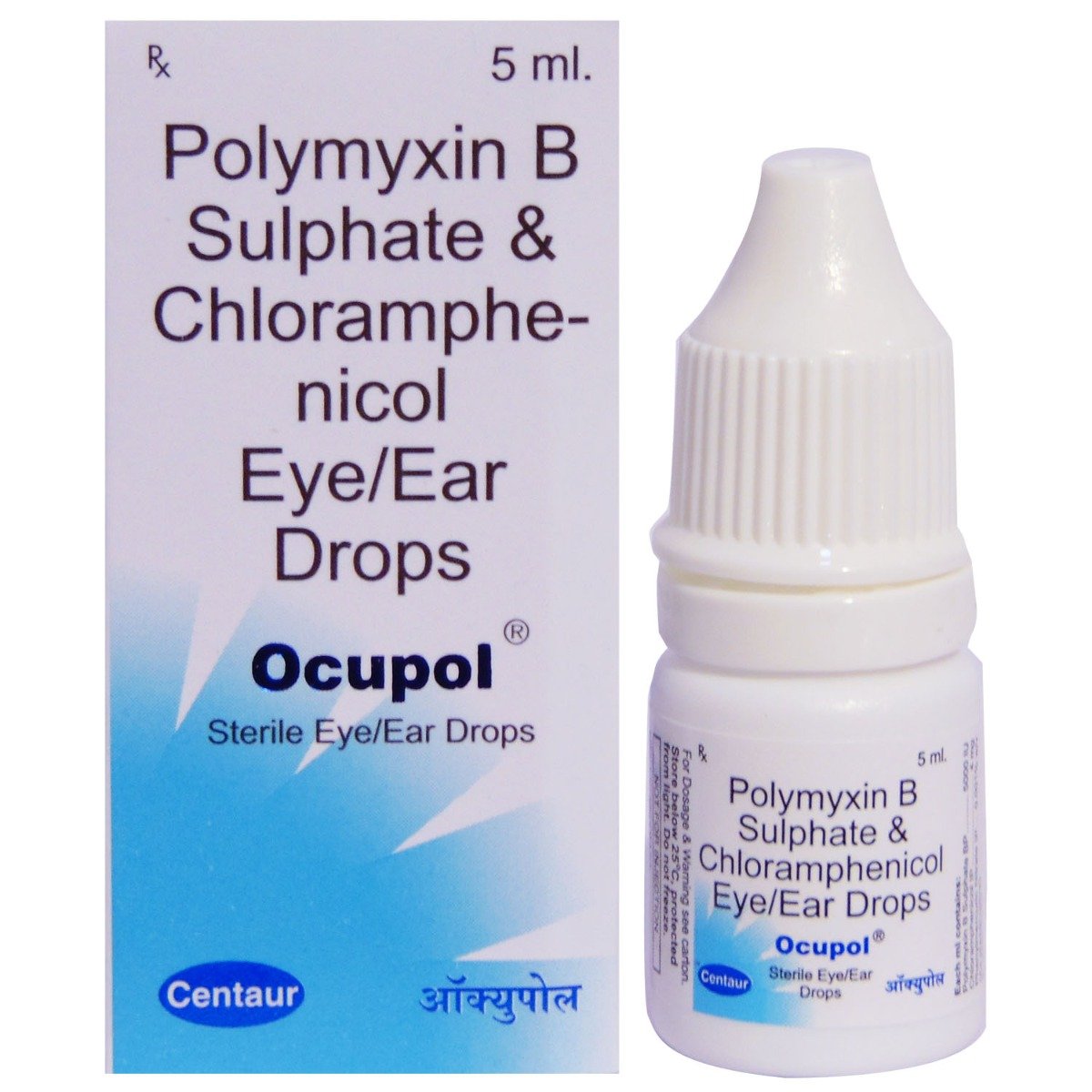Ocupol Eye/Ear Drop 5 ml








MRP ₹88.5
(Inclusive of all Taxes)
₹13.3 Cashback (15%)
Provide Delivery Location
Online payment accepted
 Prescription drug
Prescription drugWhats That
Composition :
Manufacturer/Marketer :
Consume Type :
Return Policy :
Expires on or after :
About Ocupol Eye/Ear Drop 5 ml
Ocupol Eye/Ear Drop 5 ml is a combination medicine that belongs to a group of medicines called antibiotics primarily used in the treatment of surface ocular bacterial infections involving the cornea or conjunctiva. Also, it is used to treat superficial bacterial infections of the external auditory canal and infections of fenestration cavities and mastoidectomy (surgery to remove mastoid air cells, and air bubbles in the skull near the inner ears). Bacterial infection is a condition in which harmful bacteria grow in the body and cause infection. It can infect any part of the body and multiply very quickly. Ocupol Eye/Ear Drop 5 ml does not work against infections caused by virus and fungus.
Ocupol Eye/Ear Drop 5 ml is a combination of two antibiotics namely: Polymyxin B and Chloramphenicol. Polymyxin B works by inhibiting the formation of bacterial cell walls, which are necessary for survival because they prevent unwanted substances from entering the cells and stop the leakage of cell contents. Chloramphenicol works by inhibiting the production of essential proteins required for bacteria to grow, multiply, and multiply. Bacteria are thus destroyed.
Use Ocupol Eye/Ear Drop 5 ml as prescribed by your doctor. Ocupol Eye/Ear Drop 5 ml is only for use in eyes/ears. Do not swallow or inject this medicine. You are advised to use Ocupol Eye/Ear Drop 5 ml for as long as your doctor has prescribed it for you based on your medical condition. In some cases, you may experience redness, itching, irritation, burning or stinging sensation at the application site, blurred vision, or dryness as side effects Ocupol Eye/Ear Drop 5 ml. Most of these side effects do not require medical attention and gradually resolve over time. However, if the side effects worsen or persist, please consult your doctor.
If you are allergic to Ocupol Eye/Ear Drop 5 ml or any other medicines, please tell your doctor. Ocupol Eye/Ear Drop 5 ml should be used in children only in doses prescribed by the doctor. Consult your doctor if you are pregnant or breastfeeding before using this medicine. Drive only if your vision is clear as Ocupol Eye/Ear Drop 5 ml may cause temporary blurred vision immediately after applying in the eyes. Ocupol Eye/Ear Drop 5 ml should be used with caution in cases of the perforated eardrum and in long-standing cases of chronic otitis media due to the possibility of ototoxicity (ear damage). If you are using any other drops or remedies in the ear, inform your doctor before using Ocupol Eye/Ear Drop 5 ml.
Uses of Ocupol Eye/Ear Drop 5 ml
Directions for Use
Medicinal Benefits
Ocupol Eye/Ear Drop 5 ml contains Polymyxin B and Chloramphenicol used to treat bacterial infections of the eye and ear. Polymyxin B works by inhibiting the formation of bacterial cell walls, which are necessary for survival because they prevent unwanted substances from entering the cells and stop the leakage of cell contents. Chloramphenicol works by inhibiting the production of essential proteins required for bacteria to grow, multiply, and multiply. Bacteria such as Haemophilus influenzae, Klebsiella pneumoniae, Pseudomonas aeruginosa, Staphylococcus aureus, Enterobacter aerogenes, Escherichia coli, Moraxella lacunate, Neisseria species and Streptococcus species are thus destroyed.
Storage
Drug Warnings
If you are allergic to Ocupol Eye/Ear Drop 5 ml or any other medicines, please tell your doctor. Ocupol Eye/Ear Drop 5 ml should be used in children only in doses prescribed by your doctor. Consult your doctor if you are pregnant or breastfeeding before using Ocupol Eye/Ear Drop 5 ml. Drive only if your vision is clear as Ocupol Eye/Ear Drop 5 ml may cause temporary blurred vision immediately after applying in the eyes. You are recommended not to use contact lenses during the course of Ocupol Eye/Ear Drop 5 ml as it may worsen the infection. If you get any new eye problem, or eye infection or notice any allergic reactions such as itching or redness of the eye and skin rash, please consult your doctor immediately. You are advised to maintain 10 minutes time gap between using Ocupol Eye/Ear Drop 5 ml and other eye drops. Ocupol Eye/Ear Drop 5 ml should be used with caution in cases of the perforated eardrum and in long-standing cases of chronic otitis media due to the possibility of ototoxicity (ear damage). Do not touch the tip of the container to the eye, eyelids, ear or surrounding areas as it may contaminate Ocupol Eye/Ear Drop 5 ml. If you are using any other drops or remedies in the ear, inform your doctor before using Ocupol Eye/Ear Drop 5 ml.
Drug-Drug Interactions
Drug-Drug Interactions
Login/Sign Up
Taking Flibanserin with Ocupol Eye/Ear Drop 5 ml may significantly increases the blood levels of flibanserin
How to manage the interaction:
Taking Ocupol Eye/Ear Drop 5 ml with Flibanserin is not recommended, but can be taken together if prescribed by a doctor. However, consult your doctor if you experience dizziness, lightheadedness, and fainting. Do not discontinue any medication without consulting a doctor.
Taking lomitapide with Ocupol Eye/Ear Drop 5 ml can significantly increase the blood levels of lomitapide.
How to manage the interaction:
Taking Ocupol Eye/Ear Drop 5 ml with Lomitapide is not recommended, but can be taken together if prescribed by a doctor. However, consult your doctor if you experience fever, chills, joint pain or swelling, unusual bleeding or bruising, skin rash, itching, loss of hunger, weakness, nausea, vomiting, dark colored urine, light colored stools, and yellowing of the skin or eyes. Do not discontinue any medications without consulting a doctor.
Taking Ocupol Eye/Ear Drop 5 ml with triazolam can increased the effects of Ocupol Eye/Ear Drop 5 ml.
How to manage the interaction:
Taking Triazolam with Ocupol Eye/Ear Drop 5 ml is not recommended, but can be taken together if prescribed by a doctor. In case you experience any unusual symptoms, consult a doctor. However, if you experience any unusual symptoms contact your doctor. Do not discontinue any medications without consulting a doctor.
Taking Kanamycin with Ocupol Eye/Ear Drop 5 ml can increase the risk and severity of side effects.
How to manage the interaction:
There may be a possibility of interaction between Ocupol Eye/Ear Drop 5 ml and Kanamycin, but it can be taken if prescribed by a doctor. However, if you experience hearing loss, ringing in the ears, vertigo, difficulty breathing, nausea, vomiting, a decrease in hunger, increased or decreased urine, weight gain or loss that occurs suddenly, swelling, difficulty breathing, bone pain, muscle pain, fatigue, weakness, dizziness, confusion, and irregular heartbeat, consult a doctor. Do not discontinue any medications without a doctor's advice.
Using Ocupol Eye/Ear Drop 5 ml together with streptomycin can increase the risk or severity of developing hearing loss, breathing problems, and kidney problems.
How to manage the interaction:
Although taking Ocupol Eye/Ear Drop 5 ml and Streptomycin together can cause an interaction, it can be taken if a doctor has suggested it. However, if you experience nausea, vomiting, a decrease in hunger, increased or decreased urine, weight gain or loss that occurs suddenly, fluid retention, swelling, difficulty breathing, bone pain, muscle pain, fatigue, weakness, dizziness, confusion, and irregular heartbeat, hearing loss, ringing in the ears, vertigo, consult a doctor. Do not discontinue any medication without consulting a doctor.
Taking Tenofovir alafenamide with Ocupol Eye/Ear Drop 5 ml can increase the chance of side effects.
How to manage the interaction:
Taking Tenofovir alafenamide with Ocupol Eye/Ear Drop 5 ml together can result in an interaction, but it can be taken if a doctor has advised it. However, if you experience nausea, vomiting, a decrease in hunger, increased or decreased urine, weight gain or loss that occurs suddenly, fluid retention, swelling, difficulty breathing, bone pain, muscle pain, fatigue, weakness, dizziness, confusion, and irregular heartbeat, consult a doctor. Do not discontinue any medications without a doctor's advice.
Co-administration of Netilmicin with Ocupol Eye/Ear Drop 5 ml can increase the risk of side effects.
How to manage the interaction:
Co-administration of Netilmicin with Ocupol Eye/Ear Drop 5 ml can result in an interaction, but it can be taken if a doctor has advised it. However, if you experience nausea, vomiting, a decrease in hunger, increased or decreased urine, weight gain or loss that occurs suddenly, fluid retention, swelling, difficulty breathing, bone pain, muscle pain, fatigue, weakness, dizziness, confusion, and irregular heartbeat, hearing loss, ringing in the ears, vertigo, consult a doctor. Do not discontinue any medications without a doctor's advice.
Co-administration of Ocupol Eye/Ear Drop 5 ml may increase the effects of Suxamethonium when taken in combination.
How to manage the interaction:
Co-administration of Suxamethonium with Ocupol Eye/Ear Drop 5 ml can result in an interaction, but it can be taken if a doctor has advised it. Do not stop using any medications without a doctor's advice.
Taking Human immunoglobulin with Polymyxin- b, may raise the risk of kidney problems.
How to manage the interaction:
Although taking Human immunoglobulin and Ocupol Eye/Ear Drop 5 ml together can cause an interaction, it can be taken if a doctor has suggested it. However, if you experience nausea, vomiting, loss of appetite, increased or decreased urination, sudden weight gain or loss, swelling, shortness of breath, muscle cramps, tiredness, weakness, dizziness, confusion, or an irregular heart rhythm, consult a doctor. Do not discontinue any medications without consulting a doctor.
Co-administration of Deferasirox and Ocupol Eye/Ear Drop 5 ml may increase the risk of kidney problems.
How to manage the interaction:
Although taking Ocupol Eye/Ear Drop 5 ml and Deferasirox together can result in an interaction, it can be taken if a doctor has prescribed it. However, if you experience nausea, vomiting, loss of appetite, increased or decreased urination, swelling, breathing difficulty, bone pain, muscle pain, dizziness, confusion, or irregular heart rhythm, seek immediate medical attention. Drink plenty of water if you experience diarrhea or vomiting while taking these medications, as dehydration can potentially affect the kidneys. Do not discontinue any medications without a doctor's advice.
Drug-Food Interactions
Drug-Food Interactions
Login/Sign Up
Diet & Lifestyle Advise
- Wash your hands with soap and water frequently.
- Keep your clothes, towels, and bedsheets separate from others.
- Maintain good hygiene of contact lenses. Wash your hands thoroughly before wearing and after removing contact lenses.
- Avoid wearing contact lenses while swimming. In case you use them mistakenly, get a new pair.
- Wear protective eye gear if you are cycling or trekking through the forest.
- If you have irritation in the eyes, avoid rubbing them.
- Avoid getting things like shampoo, soap, and water into the ear, as it can cause itching.
- Do not poke or scratch the ear, as it can cause damage to the ear canal, leading to inflammation. The inflamed skin can be infected by bacteria or fungi, which can cause infections in the ear.
Side Effects of Ocupol Eye/Ear Drop 5 ml
- Redness, itching, irritation, burning or stinging sensation at the application site
- Blurred vision
- Dryness
Habit Forming
Therapeutic Class
All Substitutes & Brand Comparisons
RX
Polychlor Eye/Ear Drops 5 ml
Sunways (India) Pvt Ltd
₹67.5
(₹12.16/ 1ml)
23% CHEAPER
Product Substitutes
Author Details
We provide you with authentic, trustworthy and relevant information
Drug-Diseases Interactions
Drug-Diseases Interactions
Login/Sign Up
FAQs
Ocupol Eye/Ear Drop 5 ml contains Polymyxin B and Chloramphenicol. Polymyxin B works by inhibiting the formation of bacterial cell walls, which are necessary for survival because they prevent unwanted substances from entering the cells and stop the leakage of cell contents. Chloramphenicol works by inhibiting the production of essential proteins required for bacteria to grow, multiply, and multiply. Bacteria are thus destroyed.
You are not recommended to wear contact lenses during the entire course of Ocupol Eye/Ear Drop 5 ml as it may worsen the infection. Therefore, you are advised to remove contact lenses before using Ocupol Eye/Ear Drop 5 ml and reinsert them after 24 hours of finishing the course of Ocupol Eye/Ear Drop 5 ml.
You are recommended to maintain a minimum of 10 minutes time gap between using Ocupol Eye/Ear Drop 5 ml and other eye drops and administer eye ointments in the last.
Yes, Ocupol Eye/Ear Drop 5 ml may cause temporary blurred vision when used in the eye. Therefore, you are recommended to wait until your vision is clear before driving or operating heavy machinery.
You are not recommended to stop using Ocupol Eye/Ear Drop 5 ml without consulting your doctor as abrupt stopping may increase pressure in the eyes and may lead to loss of vision. Therefore, use Ocupol Eye/Ear Drop 5 ml for as long as your doctor has prescribed it, and if you experience any difficulty while taking Ocupol Eye/Ear Drop 5 ml, please consult your doctor.
Special Advise
- Please consult a doctor if your infection persists or worsens even after using Ocupol Eye/Ear Drop 5 ml for a week.
Disease/Condition Glossary
Bacterial eye infections: The common bacterial eye infections are conjunctivitis, stye, or keratitis. Conjunctivitis (pink eye) is the infection or inflammation of the conjunctiva (white part of the eye) and the inner eyelid. It is a highly contagious infection that spreads by secretions of the eye. Symptoms include redness, itchy, and discharge or crusting around the eye. A stye, a bump on the eyelid, is also a common eye condition. Keratitis, inflammation of the cornea occurs due to frequent contact lenses, injury, diabetes, or surgery.
Ear infections: An ear infection occurs when the fungi or bacteria affect the middle or outer ear, leading to pain and inflammation. Also, when the Eustachian tubes (small tubes that run from each ear to the back of the throat) become blocked or swollen, ear infections occur. Infection of the middle ear (air-filled space behind the eardrum) is known as otitis media whereas the inflammation of the external/outer ear canal that runs from the eardrum to the outside of the head is known as otitis externa. Ear infections can be painful due to inflammation and fluid build-up. Symptoms include discomfort or pain inside the ear, pus or fluid-like drainage from the ear, feeling of pressure inside the ear, and loss of hearing.

Have a query?
Buy best Ocular products by
Entod Pharmaceuticals Ltd
Ajanta Pharma Ltd
Sunways (India) Pvt Ltd
Sun Pharmaceutical Industries Ltd
Cipla Ltd
Micro Labs Ltd
Allergan Healthcare India Pvt Ltd
Intas Pharmaceuticals Ltd
Raymed Pharmaceuticals Ltd
Nri Vision Care India Ltd
FDC Ltd
Jawa Pharmaceuticals India Pvt Ltd
Indoco Remedies Ltd
Sapient Laboratories Pvt Ltd
Senses Pharmaceuticals Pvt Ltd
Centaur Pharmaceuticals Pvt Ltd
Neomedix Healthcare India Pvt Ltd
Aromed Pharmaceuticals
Optho Remedies Pvt Ltd
Aurolab
Austrak Pvt Ltd
Lupin Ltd
Mankind Pharma Pvt Ltd
Zivira Labs Pvt Ltd
Optho Pharma Pvt Ltd
Synovia Life Sciences Pvt Ltd
Akumentis Healthcare Ltd
Eyekare
His Eyeness Ophthalmics Pvt Ltd
Protech Remedies Pvt Ltd
Runyon Pharmaceutical Pvt Ltd
Alcon Laboratories Inc
Syntho Pharmaceuticals Pvt Ltd
Alembic Pharmaceuticals Ltd
Bell Pharma Pvt Ltd
Klar Sehen Pvt Ltd
Sentiss Pharma Pvt Ltd
Irx Pharmaceuticals Pvt Ltd
Optho Life Sciences Pvt Ltd
Phoenix Remedies Pvt Ltd
Alkem Laboratories Ltd
Doctor Wonder Pvt Ltd
Hicare Pharma
Ipca Laboratories Ltd
Neon Laboratories Ltd
Okulus Drugs India
Pharmtak Ophthalmics (I) Pvt Ltd
Berry & Herbs Pharma Pvt Ltd
Glow Vision Pharmaceuticals
Kaizen Drugs Pvt Ltd
Choroid Laboratories Pvt Ltd
Indiana Opthalamics Pvt Ltd
Optica Pharmaceutical Pvt Ltd
Pharmatak Opthalmics India Pvt Ltd
Samarth Life Sciences Pvt Ltd
Vibgyor Vision Care
Mofon Drugs
Novartis India Ltd
Pharmia Biogenesis Pvt Ltd
Zydus Cadila
Appasamy Ocular Devices Pvt Ltd
Leeford Healthcare Ltd
Medivision Pharma Pvt Ltd
Orbit Life Science Pvt Ltd
X-Med Royal Pharma Pvt Ltd
Zee Laboratories Ltd
Aarma Laboratories
Guerison MS Inc
Laborate Pharmaceuticals India Ltd
Xtas Pharmaceuticals
Accurex Biomedical Pvt Ltd
Blucrab Pharma Pvt Ltd
Does Health Systems Pvt Ltd
Flagship Biotech International Pvt Ltd
Lavue Pharmaceuticals Pvt Ltd
Nutrilis Healthcare Pvt Ltd
Ursa Pharm India Pvt Ltd
Vee Remedies
Vyonics Health Care India Pvt Ltd
Warren Pharmaceuticals Pvt Ltd
Abbott India Ltd
Accvus Pharmaceuticals
Akums Drugs & Pharmaceuticals Ltd
Cadila Healthcare Ltd
Carevision Pharmaceuticals Pvt Ltd
Dey's Medical Stores (Mfg) Ltd
East West Pharma India Pvt Ltd
Eyedea Pharmaceuticals Pvt Ltd
Nimbus Healthcare Pvt Ltd
Ocuris Pharmaceuticals Pvt Ltd
Sherings Pharmaceuticals
Tarks Pharmaceuticals Pvt Ltd
Vcan Biotech
Vision Medilink
Aice Health Care Pvt Ltd
Appasamy Pharmaceuticals Pvt Ltd
Asperia Lifescience Pvt Ltd
Beatum Healthcare Pvt Ltd
East India Pharmaceutical Works Ltd
Grevis Pharmaceutical Pvt Ltd
Alcohol
Caution
Interaction of alcohol with Ocupol Eye/Ear Drop 5 ml is unknown. Please consult your doctor in case of any concerns.
Pregnancy
Caution
If you are pregnant, consult your doctor before using Ocupol Eye/Ear Drop 5 ml. Your doctor may prescribe this medicine if the benefits outweigh the risks.
Breast Feeding
Caution
There are no adequate and well-controlled studies on the use of Ocupol Eye/Ear Drop 5 ml in breastfeeding mothers. Therefore, if you are breastfeeding, consult your doctor before using Ocupol Eye/Ear Drop 5 ml.
Driving
Caution
Ocupol Eye/Ear Drop 5 ml may cause blurred vision immediately after using it in the eyes. So, wait until your vision is clear before driving or operating machinery.
Liver
Safe if prescribed
If you have any concerns regarding the use of Ocupol Eye/Ear Drop 5 ml in patients with liver problems, please consult a doctor.
Kidney
Safe if prescribed
If you have any concerns regarding the use of Ocupol Eye/Ear Drop 5 ml in patients with kidney problems, please consult a doctor.
Children
Caution
Ocupol Eye/Ear Drop 5 ml should be used in children in doses prescribed by a doctor.





_0.jpg?tr=q-85)
